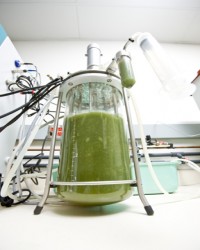We Can Cut Greenhouse Gases to Zero, But We Probably Won’t

The technology is ready to provide all the energy the world needs with zero carbon emissions, using only wind, water and sunlight. So says a November 2009 Scientific American article by Mark Z. Jackson and Mark A. Deluchi, “A Path to Sustainable Energy by 2030.” It would take commitment, money, and planning, but it could be done. The infrastructure to generate the power would take billions of dollars, and more billions would need to be spent on our grid infrastructure to swiftly and efficiently dispatch energy when and where it is needed.
Yet we are already spending billions on ever more esoteric means of digging up fossil fuels, on energy security, and on combating the various effects of fossil fuels, from uncontrolled oil spills to environmental devastation from mining coal to local air pollution, not to mention global warming.What are we waiting for? Perhaps the biggest technical problem is intermittency, the fact that wind and sunlight come and go and are not always available when needed. This could be handled by what Scientific American calls a “smart balance,” overlapping different forms of renewable energy as needed. Since wind is often unavailable at peak sun times and sun is often unavailable at peak wind times, the two complement each other. In addition, solar thermal is capable of providing baseline power to overcome the intermittency problem. The article only briefly mentions geothermal power, yet this underutilized energy source is also able to provide baseline power with no carbon emissions.
One problem is that wind, water, and solar generate electricity, which is not transferable to cars and trucks that depend on oil. The solution—battery powered automobiles—is currently bounding ahead, but will still take years, if not decades, to become a major part of our transportation fleet. Perhaps the article should have further discussed the use of liquid natural gas (LNG), which would serve as an excellent intermediary fuel. Perhaps more buses and trucks could be fitted to run on LNG?
The Biofuel Holdup
Another issue cited by the article is biofuels. True, the corn-based biofuel in the U.S. might give off as many carbon emissions as it saves, but there are other biofuels out there. Brazil, with its bountiful sugar-based biofuel (much more efficient than the corn-based stuff) has managed to completely free itself from foreign oil—something the U.S. can only envy. Getting rid of our tariffs on Brazilian biofuel would be one way to improve the efficiency of our fuel (we’d want to couple this with guarantees from Brazil that they wouldn’t chop down more rainforest to clear land for sugar cane).
Another possibility is the use of algal biofuels, just beginning to be used for jet fuel. Work should proceed apace on this. If battery technology proves expensive and unwieldy, perhaps algal biofuel will be the best way to power our cars?
Losing Steam
It’s conceivable that the Scientific American article is overly optimistic about the technological difficulties of getting wind, water, and sun power to areas where those resources are scarce. In these cases, we may need to rely on nuclear power. True, it’s expensive and produces deadly wastes, but it’s still better than adding greenhouse gasses to the atmosphere. What’s important is that we have a comprehensive plan that weighs the cost and impact of different energy solutions in different areas. It’s also important to maintain some flexibility; should one solution prove more difficult than anticipated, we need a backup plan in place.
Unfortunately, this planning has not taken place. The fact that the U.S. hasn’t seriously worked on a comprehensive energy plan shows a total failure to take climate change seriously, a failure of vision, of the ability to plan and to implement grand schemes that made us the world’s greatest power in the 20th century. On our current path, we’re doomed to become a has-been power in the 21st century, capable of leading the world only to the brink of disaster.

